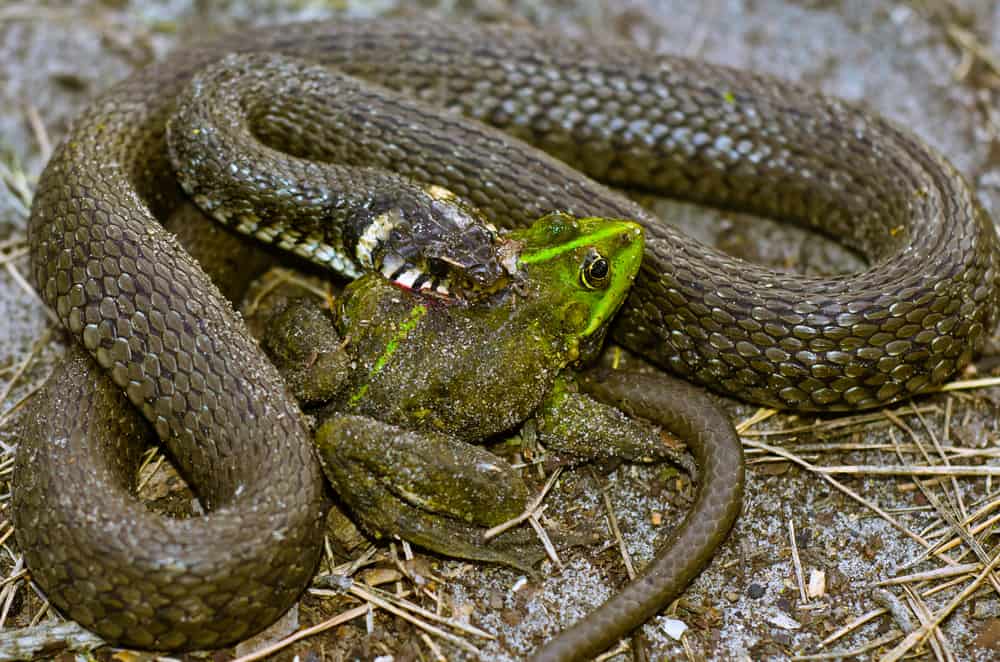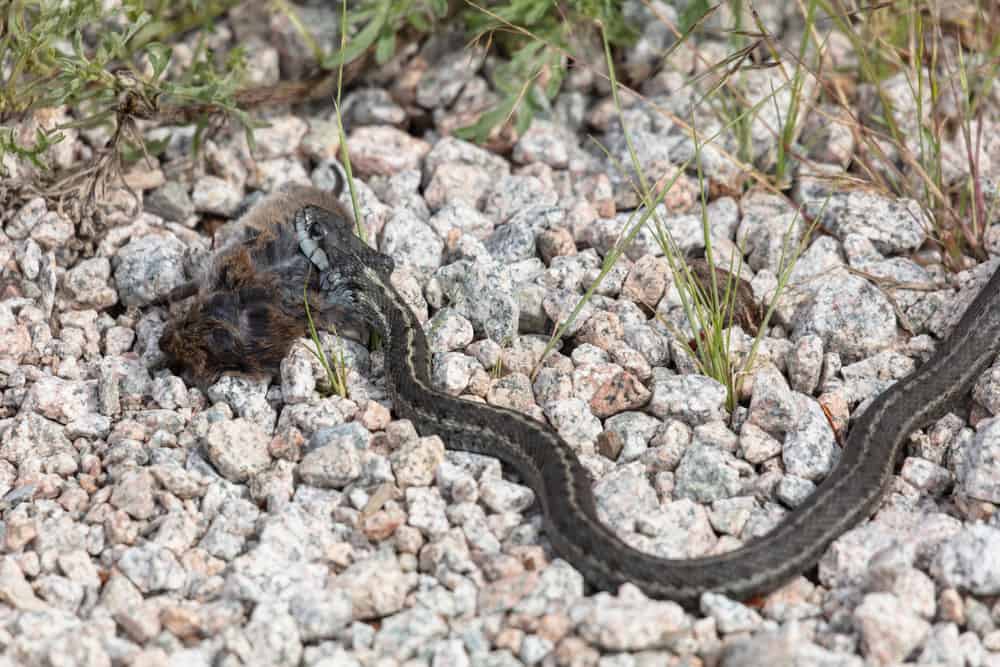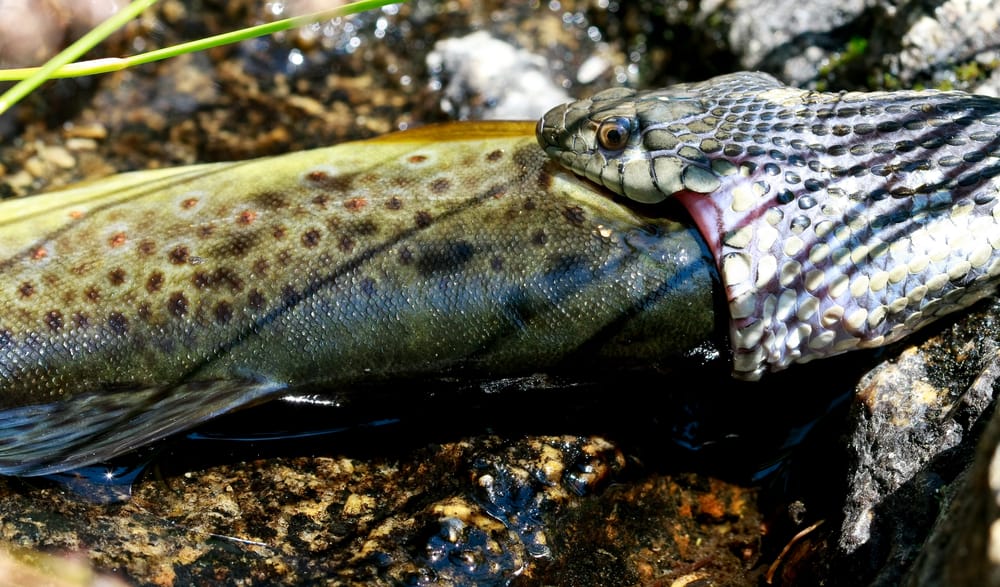Snakes are generally notorious, and only a few dedicated admirers have decided to keep them as pets. Garter snakes are no exception, although these venomous creatures can’t harm humans.
They have an attractive appearance and are active during the day, thus making perfect pets for some people. If you decide to get one, you will probably wonder what do Garter snakes eat. Let’s see.
Garter Snakes Habits and Biology
Garter snakes are highly adaptable serpents, and you can find them practically everywhere. Their typical habitats are forests, fields, gardens, but they are also not rare in urban areas.
Generally, Garter snakes are small reptiles, with an average length of 30 inches (76 cm). However, some adults can grow up to 5 feet (1.5 m).
Most Garter snakes don’t lay eggs. Instead, they are live-born reptiles with an average litter size of 15 to 20 newborns. However, biologists state cases where the mother snake had over 80 baby snakes in only one birthing.
However, you can find an exception to this rule. Aquatic Garter snakes lay eggs with small litters that include a maximum of 20 newborns.
According to ITIS (Integrated Taxonomic Information System), there are 30 different Garter snakes species. They all have three long stripes on their back.
Scientific classification |
Gartner snake |
| Kingdom | Animalia |
| Phylum | Chordata |
| Class | Reptilia |
| Order | Squamata |
| Family | Colubridae |
| Genus | Thamnophis |
| Species | 30 known |
The most well-known are:
- Eastern Garter snake
- Common Garter snake
- Red-sided Garter snake
- San Francisco Garter snake
- Checkered Garter snake
Some species have additional colorful ornaments between the stripes, while other’s lines are barely noticeable. For example, the Texas Garter snake has an intense red stripe in the middle of its back with two light-colored lines around it.
Contrary, the Checkered Garter snake has three thin lines. As the name suggests, its ornament is a dark checkered pattern all over the body.
Typically, Garter snakes are shy creatures that prefer solitude, but tend to hibernate in large groups during the winter months. The snake number in one nest during hibernation may reach a thousand. Plus, garters don’t mind sharing the nest with other snake species.
As soon as spring comes, you can see Garter snakes lying on rocks near a pond or a river, absorbing the sun’s warmth. However, they will slip into the water at the first sign of danger because they are great swimmers.
Do Garter Snakes Eat Dirt?
Garter snakes are carnivores, and they don’t eat dirt. Simply put, it doesn’t contain any nutrient a snake need. However, you may see the young ones gliding through dirt, sand, and fallen leaves while searching for earthworms and other small prey.
If you spot a Garter snake in your yard and want to chase it away, you should clean around. Cut the grass, trim bushes, and remove rocks and leaves. Since this snake prefers avoiding human contact, it will leave if there is nowhere to hide.
What Do Garter Snakes Like to Eat Most
Garter snakes are carnivores. There is a saying that they are gardener’s best friends since they kill small creatures damaging plants and veggies.
Typically, Garter snakes go hunting in the morning or evening, and they will rarely feed overnight. Still, these serpents are adaptable creatures, and they won’t miss an opportunity to eat when something delicious comes up.
They are also not very selective when it comes to their diet. For example, these snakes can eat toads, although they have toxic secretion over the skin. This toxin repeals other animals, but garters are immune to it.
The only limitation is the meal size. A baby Garter snake can’t swallow a large bird or chicken, but it will feed on slugs and fish without any trouble. As your snake grows, its list of prey gets longer.
Luckily, you won’t have to worry about it swallowing your other pets, like cats and dogs, since they are too large to gulp. Still, keep your hamster safe if you have one.
Garter’s saliva contains a neurotoxin that paralyzes the victim. Then, the snake swallows the whole prey savoring it later. Some Garter snake targets are:
- Earthworms, leeches, and grubs
- Frogs and toads
- Tadpoles
- Snails and slugs
- Sowbugs, cucumber beetles, and grasshoppers
- Salamanders and other snakes
- Mice, shrews, and voles
- Chipmunks
- Small birds
- Fish and chicken
- Carrion
If you have a Garter snake for a pet, you should provide it with all necessary nutrition by feeding it with rodents and fish. However, keep in mind that many fish contain thiaminase, which harms Garter snakes. The safe-to-eat fish list includes:
- Ayu, pumpkinseed
- Bass, Cod, and bluegill
- Chub and sea catfish
- Crappie and seabass
- Cunner and croaker
- Herring and pollock
- Pike and tautog
- Dogfish, lizard fish, and cutlassfish (silver eel)
- Squid
The list is long, and you can combine different fish with mice and worms. Most pet stores offer a variety of food for your snake.
Supplements for Garter snake
In some cases, you can include a calcium powder supplement in your pet’s diet. If you feed a garter with boneless food, you need to sprinkle some vitamins over it. Keep in mind that your snake needs vitamin D to metabolize calcium.
Gartner snakes provide vitamin D by taking their time in the sun. Therefore, your pet snake needs a UV lamp or some extra supplements to make up for it.
Never overdo it with powders since too many vitamins can harm an animal. Vitamin D accumulates in the reptile’s body, and it can become toxic at some level. Enriching one of every two or three meals will be enough to keep your pet healthy.
Food Avoid to Feed Garter Snakes
As I already mentioned, the Garter snakes are carnivores, and they will eat any meat you provide. However, some food can make your pet sick, cause stomach irritation or skin problems. Therefore, avoid feeding a Garter snake with human food, including:
- Bread
- Sweets
- Meat pie and dairy products
- Fruit and veggies
- Tobacco
Giving your Garter snake a commercial food for dogs or cat is also a bad idea. These cans and granules follow a canine or feline nutritional need, and a Garter snake won’t benefit from them.
Plus, they can fatten the snake causing its health problems. You also need to avoid ground and processed meat, as well as all meat byproducts. A Garter snake needs raw and unsalted meat.
Once you get a snake, consult a vet specialized in reptiles about its diet. The internet is full of unverified and inaccurate information, so it can lead you into giving a Garter snake a goldfish, for example.
A goldfish contains thiaminase, just like some other fish. This enzyme reduces vitamin B absorption, resulting in a degenerative collapse of the central nervous system and death. Other fish with this harmful chemical you should never offer to your pet are:
- Lake whitefish, butterfish, and white bass
- Sculpin and fathead minnow
- Catfish and Baltic herring
- Clams
Keep in mind that even thiaminase-free fish can contain methyl mercury, so it is a better option to buy snake food in pet stores.
Even though the Garter snake hunts in the wild, that doesn’t mean you can feed it with earthworms from your yard since they often carry harmful parasites. The same goes for toads, slugs, and mice. Additionally, you should avoid some substrates, like:
- Sand, gravel, and clay
- Corn cob
- Sawdust
- Cat litter
The dirt you bring from your backyard often contains pesticides, bacteria, and mold. Once you carry it inside, a stable, warm temperature will fasten microorganism reproduction and cause a problem.
Tips to Feed Garter Snakes
Taking care of a Garter snake isn’t much of a challenge. This snake is relatively small, and it won’t bite or attack unless you provoke it. Its attractive appearance and the fact it is active during the day make it an appealing pet. Still, there are few things to remember:
- Feed your snake with chopped fish and raw meat without any salt or spices
- Adult snake needs meal every 7 to 10 days while a baby garter and pregnant female eats every 4 to 5 days
- Provide fresh water daily
- Allow your pet to hunt by placing a live fish in water and letting it catch it
- Avoid overfeeding since snake can quickly become obese
- Your new snake can refuse to eat in a new habitat, so you should give it a week or two to adapt
Finally, you should never catch a Garter snake in the wild or even in your backyard. Go to a pet store and buy your pet. Remember that Garter snakes are protected by law in some countries, so you should check regulations in your state before taking one.
Summary
Garter snakes are adaptable creatures that can live almost anywhere. They are carnivores with a long list of possible targets, including rodents, fish, other snakes, and snails. Be careful since some fish may be harmful to Garter snakes. Earthworms and mice are among their favorite food, and you can buy those in most pet stores.


